Unit 1 Nature in the balance Welcome to the unit Reading课件(17张)
文档属性
| 名称 | Unit 1 Nature in the balance Welcome to the unit Reading课件(17张) | 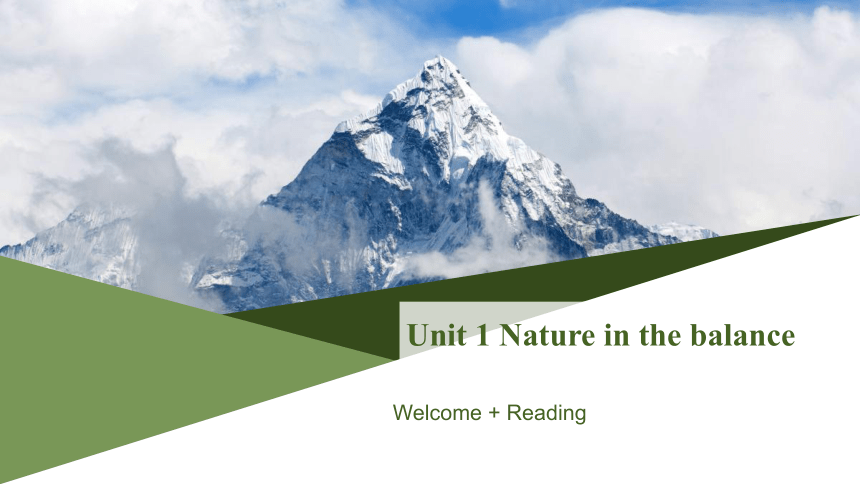 | |
| 格式 | pptx | ||
| 文件大小 | 8.0MB | ||
| 资源类型 | 教案 | ||
| 版本资源 | 牛津译林版(2019) | ||
| 科目 | 英语 | ||
| 更新时间 | 2022-03-21 20:29:21 | ||
图片预览


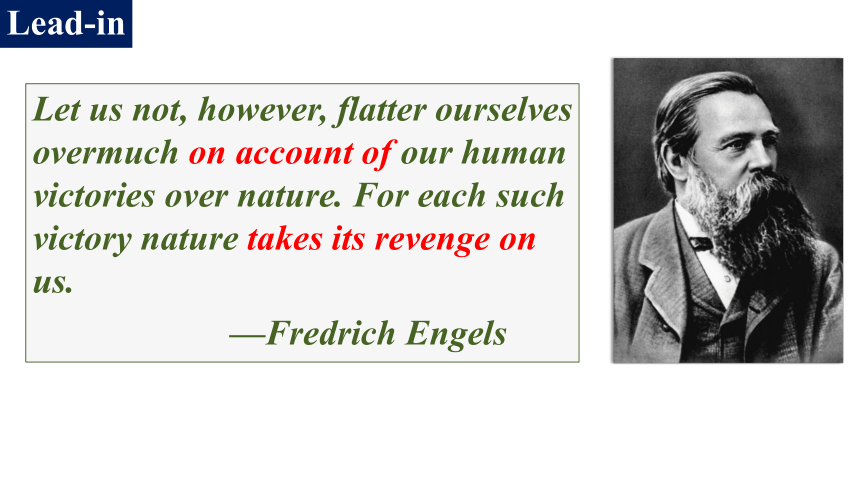
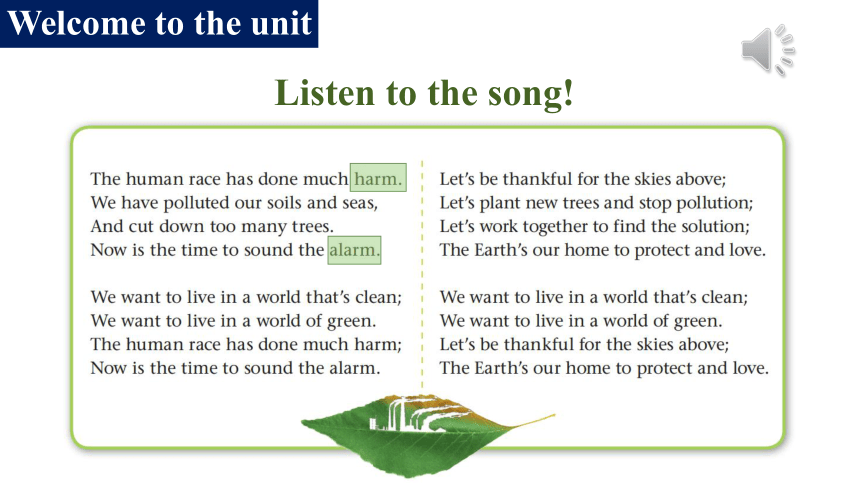
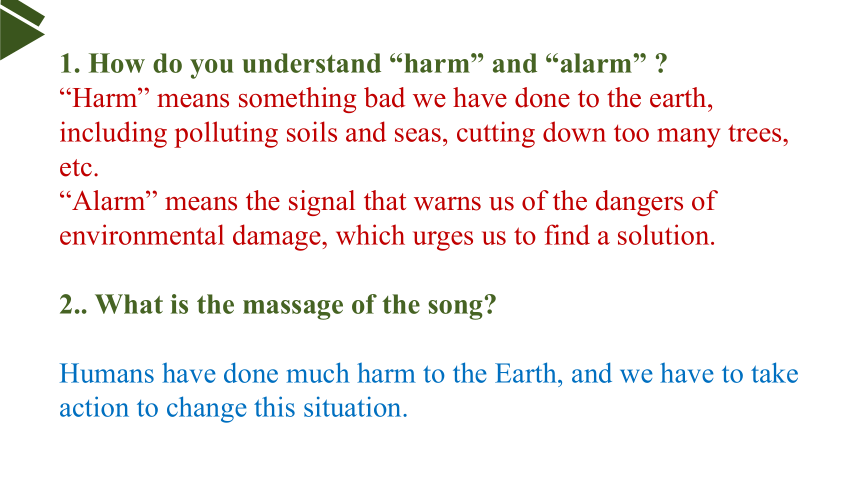
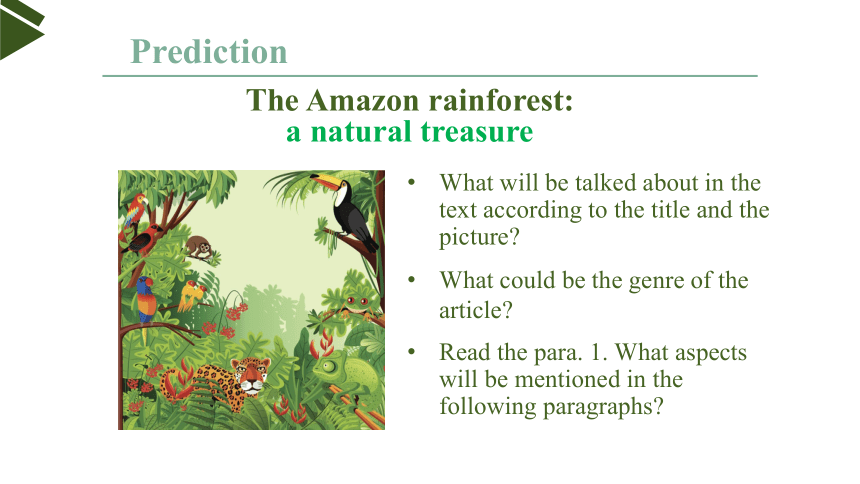
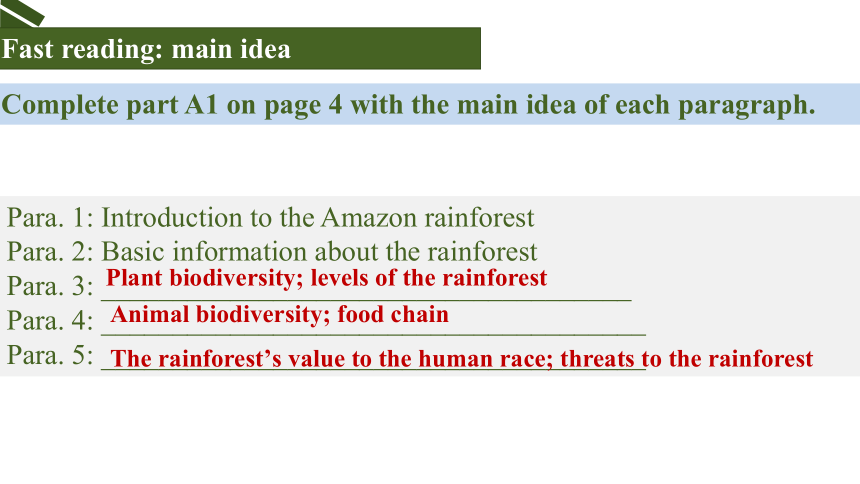
文档简介
(共17张PPT)
Unit 1 Nature in the balance
Welcome + Reading
rainforest
The oldest living ecosystems on the planet:
Some can trace their origins to 70 million years ago
two types: temperate and tropical
make up about 6% of the surface area
home to over half of the World’s plant and animal species
in addition to ingredients useful in everyday products and medicines, in fact, an estimated 70% of the plants used in cancer treatments are only found in rainforests.
absorb vast amounts of carbon dioxide and convert them into oxygen, about 40% of the planet’s breathable air.
At the current rate, rainforest may completely disappear within the next century.
Lead-in
Let us not, however, flatter ourselves overmuch on account of our human victories over nature. For each such victory nature takes its revenge on us.
—Fredrich Engels
Welcome to the unit
Listen to the song!
1. How do you understand “harm” and “alarm”
“Harm” means something bad we have done to the earth, including polluting soils and seas, cutting down too many trees, etc.
“Alarm” means the signal that warns us of the dangers of environmental damage, which urges us to find a solution.
2.. What is the massage of the song
Humans have done much harm to the Earth, and we have to take action to change this situation.
The Amazon rainforest:
a natural treasure
What will be talked about in the text according to the title and the picture
What could be the genre of the article
Prediction
Read the para. 1. What aspects will be mentioned in the following paragraphs
Para. 1: Introduction to the Amazon rainforest
Para. 2: Basic information about the rainforest
Para. 3: _____________________________________
Para. 4: ______________________________________
Para. 5: ______________________________________
Plant biodiversity; levels of the rainforest
Animal biodiversity; food chain
The rainforest’s value to the human race; threats to the rainforest
Complete part A1 on page 4 with the main idea of each paragraph.
Fast reading: main idea
6,400
6 million
8
17%
20%
400
40,000
1,300
Fast reading: figures
What is the purpose of using so many figures
Besides just listing the figures, how does the script make the figures, the large figures in particular, understandable
To support the statement and make the statement more persuasive and convincing; to vivify the figures and the facts;
Think about two questions:
By making comparisons with figures.
a system of roots
The forest’s different levels support an unbelievable variety of wildlife.
the tops of the
tallest trees
the mass of leaf litter
shorter plants with large leaves
towering ancient hardwoods
Read para. 3 and figure out different layers of the forest.
Jaguars
Insects
At least 87 species, including frogs
Leaves and fruit
Microorganisms
feed on
break down
feed on
feed on
While a significant number of jaguars survive here, they are only one element of this forest’s food chain.
Read para. 4 and figure out the food chain of a jaguar.
What makes the Amazon rainforest a natural treasure according to the script
What is your answer to the question at the end of the script Can we afford to damage the “lungs of the plant”
What can we do to help maintain a delicate ecological balance
Discussion
Read para. 5 and discuss the following questions
The Amazon rainforest is unique, beautiful and valuable. It contains 10% of all known species on the Earth. It produces over 20% of the planet's oxygen. Its wonderful plant and animal species have enabled humans to make amazing discoveries.
What makes the Amazon rainforest a natural treasure
according to the script
No. The Amazon rainforest is far too important for us to allow it to be destroyed. It helps maintain the balance of the ecosystem and provides our society with food and medicine.
2. What is your answer to the question at the end of the script
Can we afford to damage the “lungs of the plant”
Reduce, reuse, and recycle. Cut down on what you throw away. Follow the three "R's" to conserve natural resources and landfill space.
Shop wisely. Buy less plastic and bring a reusable shopping bag.
Use long-lasting light bulbs. Energy efficient light bulbs reduce greenhouse gas emissions. Also flip the light switch off when you leave the room!
Plant a tree. Trees provide food and oxygen. They help save energy, clean the air, and help combat climate change.
Bike more. Drive less. take public transports.
3. What can we do to help maintain a delicate ecological balance
Let us not, however, flatter ourselves overmuch on account of our human victories over nature. For each such victory nature takes its revenge on us.
—Fredrich Engels
Unit 1 Nature in the balance
Welcome + Reading
rainforest
The oldest living ecosystems on the planet:
Some can trace their origins to 70 million years ago
two types: temperate and tropical
make up about 6% of the surface area
home to over half of the World’s plant and animal species
in addition to ingredients useful in everyday products and medicines, in fact, an estimated 70% of the plants used in cancer treatments are only found in rainforests.
absorb vast amounts of carbon dioxide and convert them into oxygen, about 40% of the planet’s breathable air.
At the current rate, rainforest may completely disappear within the next century.
Lead-in
Let us not, however, flatter ourselves overmuch on account of our human victories over nature. For each such victory nature takes its revenge on us.
—Fredrich Engels
Welcome to the unit
Listen to the song!
1. How do you understand “harm” and “alarm”
“Harm” means something bad we have done to the earth, including polluting soils and seas, cutting down too many trees, etc.
“Alarm” means the signal that warns us of the dangers of environmental damage, which urges us to find a solution.
2.. What is the massage of the song
Humans have done much harm to the Earth, and we have to take action to change this situation.
The Amazon rainforest:
a natural treasure
What will be talked about in the text according to the title and the picture
What could be the genre of the article
Prediction
Read the para. 1. What aspects will be mentioned in the following paragraphs
Para. 1: Introduction to the Amazon rainforest
Para. 2: Basic information about the rainforest
Para. 3: _____________________________________
Para. 4: ______________________________________
Para. 5: ______________________________________
Plant biodiversity; levels of the rainforest
Animal biodiversity; food chain
The rainforest’s value to the human race; threats to the rainforest
Complete part A1 on page 4 with the main idea of each paragraph.
Fast reading: main idea
6,400
6 million
8
17%
20%
400
40,000
1,300
Fast reading: figures
What is the purpose of using so many figures
Besides just listing the figures, how does the script make the figures, the large figures in particular, understandable
To support the statement and make the statement more persuasive and convincing; to vivify the figures and the facts;
Think about two questions:
By making comparisons with figures.
a system of roots
The forest’s different levels support an unbelievable variety of wildlife.
the tops of the
tallest trees
the mass of leaf litter
shorter plants with large leaves
towering ancient hardwoods
Read para. 3 and figure out different layers of the forest.
Jaguars
Insects
At least 87 species, including frogs
Leaves and fruit
Microorganisms
feed on
break down
feed on
feed on
While a significant number of jaguars survive here, they are only one element of this forest’s food chain.
Read para. 4 and figure out the food chain of a jaguar.
What makes the Amazon rainforest a natural treasure according to the script
What is your answer to the question at the end of the script Can we afford to damage the “lungs of the plant”
What can we do to help maintain a delicate ecological balance
Discussion
Read para. 5 and discuss the following questions
The Amazon rainforest is unique, beautiful and valuable. It contains 10% of all known species on the Earth. It produces over 20% of the planet's oxygen. Its wonderful plant and animal species have enabled humans to make amazing discoveries.
What makes the Amazon rainforest a natural treasure
according to the script
No. The Amazon rainforest is far too important for us to allow it to be destroyed. It helps maintain the balance of the ecosystem and provides our society with food and medicine.
2. What is your answer to the question at the end of the script
Can we afford to damage the “lungs of the plant”
Reduce, reuse, and recycle. Cut down on what you throw away. Follow the three "R's" to conserve natural resources and landfill space.
Shop wisely. Buy less plastic and bring a reusable shopping bag.
Use long-lasting light bulbs. Energy efficient light bulbs reduce greenhouse gas emissions. Also flip the light switch off when you leave the room!
Plant a tree. Trees provide food and oxygen. They help save energy, clean the air, and help combat climate change.
Bike more. Drive less. take public transports.
3. What can we do to help maintain a delicate ecological balance
Let us not, however, flatter ourselves overmuch on account of our human victories over nature. For each such victory nature takes its revenge on us.
—Fredrich Engels
同课章节目录
- Unit 1 Nature in the balance
- Welcome to the unit
- Reading
- Grammar and usage
- Integrated skills
- Extended reading
- Project
- Unit 2 Natural disasters
- Welcome to the unit
- Reading
- Grammar and usage
- Integrated skills
- Extended reading
- Project
- Unit 3 The world online
- Welcome to the unit
- Reading
- Grammar and usage
- Integrated skills
- Extended reading
- Project
- Unit 4 Scientists who changed the world
- Welcome to the unit
- Reading
- Grammar and usage
- Integrated skills
- Extended reading
- Project
